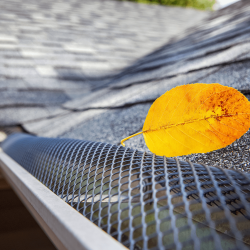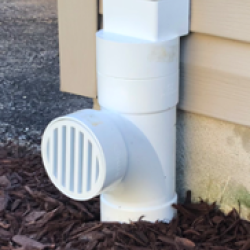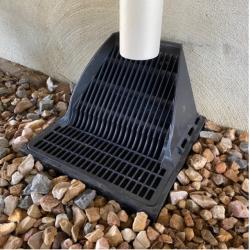Four Tips to Protect Your Drainage System This Winter

Winter months in freezing climates can present real challenges to the performance of a landscape drainage system, especially when the ground is frozen solid and rains occur. Taking steps to winterize your drainage system can help ensure the system is designed and installed properly to drain rain runoff and eliminate standing water in low points than can potentially freeze solid. Water that can’t properly drain can cause dangerous ice to form on walkways and driveways. Come spring, when ice thaws against home foundations, it can lead to water damage in basements or crawlspaces. Regular inspection and maintenance of the system, especially ahead of freezing temperatures can help get your system ready for the colder months ahead.
Here are some simple winterizing tips that can keep your drainage system working at their best even during the chilliest times of the year.
1. For area drains, catch basins, and channel drains:
Check the inlet grate surfaces and clear any debris such as mulch, lawn clippings, and leftover fall leaves that might clog the grate openings. Remove the grates to inspect the drain piping, catch basin, or channel drain interiors and clear away any accumulated debris. If the basin sump is holding water, you should consider drilling 1/4-inch weepholes to allow excess water to infiltrate into the ground. Inspect the outlet piping to ensure that they are clear and draining freely. Remove any debris stuck in the pipeline with a pipe snake.
2. For gutters and downspouts:

Clear any remaining fall leaves from all gutters before winter sets in. Downspouts discharging water near or against foundations in winter can lead to property damage and flooding of crawlspaces and basements, especially when the surrounding ground is frozen. You might wonder, how can there be water damage when temperatures are freezing? The soil against the foundation likely isn’t frozen as it is often warmed by radiant heat from inside the basement that transfers through the foundation wall. Without a proper capture device installed, this creates a direct avenue for downspout runoff to end up against the foundation and find its way into the basement. Make sure downspout aprons or splash blocks are correctly aligned and directing flows away from the foundation.
If the downspout is connected directly to buried drain pipe with an adapter, you must provide an inline outlet to allow proper outflow if the downstream piping freezes solid. One way to do this is to add a sweep tee and overflow grate beneath the downspout adapter that is directed away from the foundation.
3. For sump pump discharge lines:

Sump pump discharge lines exiting a building foundation above ground and turning down to a buried piping system should have an air gap provided above or at grade. An air gap, in this context, means that the system is not closed. In other words, if water in the downstream pipe freezes into solid ice, the system won’t back up to the pump and cause interior flooding since pumped water can still exit the discharge pipe each time the pump cycles.
One way to do this is to have the pump discharge line drain at grade to a Downspout Defender™ grate connected to the downstream system piping. An electric de-icing heater line connected to a power supply can also be used for additional protection within the downstream piping.
4. For system discharge or overflow points:
Many drainage systems will outlet horizontally to an exposed pipe at a low point in the landscape, while others discharge vertically to a pop-up drainage emitter. Clear any leaves or debris away from the grate or emitter cover and remove them to inspect the piping below. NDS® pop-up drainage emitter assemblies include a pipe elbow that has a molded-in weephole to help prevent freezing in cold weather (and prevent stagnation during warmer weather). Ideally, several inches of gravel is placed beneath the weephole to allow for free drainage into surrounding soils. If the elbow and piping are holding water, then the weephole may be clogged and should be cleared to allow the outlet location to fully drain. If the pop-up emitter is connected to an elbow where there is no weephole in the bottom turn, consider drilling a 1/2-inch hole in the lowest accessible point to prevent standing water. If a hole can’t be drilled, you may need to add an additional surface outlet point upstream in the drainage system piping.
Don’t let freezing temperatures shut down your drainage system. With these tips, you can make sure that your system is prepared to withstand those frosty, late winter months. In fact, regular inspection and maintenance can ensure that you get the most out of your system performance any time of year.
For more information on products, resources such as how-to videos, and expert support, visit NDSpro.com.
